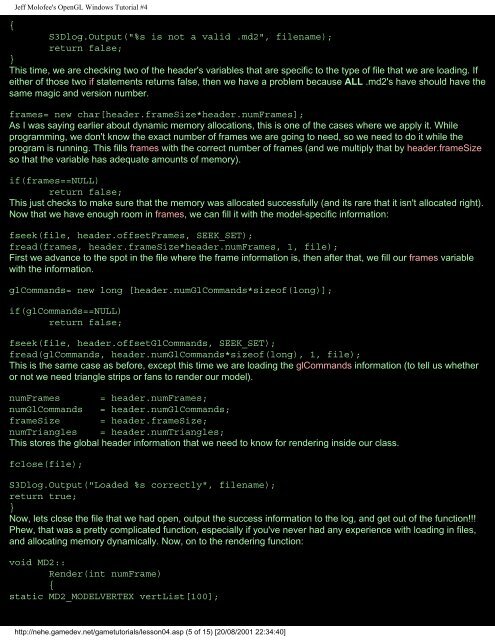Trent Polack's OpenGL Game Programming Tutorials
Trent Polack's OpenGL Game Programming Tutorials
Trent Polack's OpenGL Game Programming Tutorials
Create successful ePaper yourself
Turn your PDF publications into a flip-book with our unique Google optimized e-Paper software.
Jeff Molofee's <strong>OpenGL</strong> Windows Tutorial #4<br />
{<br />
S3Dlog.Output("%s is not a valid .md2", filename);<br />
return false;<br />
}<br />
This time, we are checking two of the header's variables that are specific to the type of file that we are loading. If<br />
either of those two if statements returns false, then we have a problem because ALL .md2's have should have the<br />
same magic and version number.<br />
frames= new char[header.frameSize*header.numFrames];<br />
As I was saying earlier about dynamic memory allocations, this is one of the cases where we apply it. While<br />
programming, we don't know the exact number of frames we are going to need, so we need to do it while the<br />
program is running. This fills frames with the correct number of frames (and we multiply that by header.frameSize<br />
so that the variable has adequate amounts of memory).<br />
if(frames==NULL)<br />
return false;<br />
This just checks to make sure that the memory was allocated successfully (and its rare that it isn't allocated right).<br />
Now that we have enough room in frames, we can fill it with the model-specific information:<br />
fseek(file, header.offsetFrames, SEEK_SET);<br />
fread(frames, header.frameSize*header.numFrames, 1, file);<br />
First we advance to the spot in the file where the frame information is, then after that, we fill our frames variable<br />
with the information.<br />
glCommands= new long [header.numGlCommands*sizeof(long)];<br />
if(glCommands==NULL)<br />
return false;<br />
fseek(file, header.offsetGlCommands, SEEK_SET);<br />
fread(glCommands, header.numGlCommands*sizeof(long), 1, file);<br />
This is the same case as before, except this time we are loading the glCommands information (to tell us whether<br />
or not we need triangle strips or fans to render our model).<br />
numFrames = header.numFrames;<br />
numGlCommands = header.numGlCommands;<br />
frameSize = header.frameSize;<br />
numTriangles = header.numTriangles;<br />
This stores the global header information that we need to know for rendering inside our class.<br />
fclose(file);<br />
S3Dlog.Output("Loaded %s correctly", filename);<br />
return true;<br />
}<br />
Now, lets close the file that we had open, output the success information to the log, and get out of the function!!!<br />
Phew, that was a pretty complicated function, especially if you've never had any experience with loading in files,<br />
and allocating memory dynamically. Now, on to the rendering function:<br />
void MD2::<br />
Render(int numFrame)<br />
{<br />
static MD2_MODELVERTEX vertList[100];<br />
http://nehe.gamedev.net/gametutorials/lesson04.asp (5 of 15) [20/08/2001 22:34:40]

















